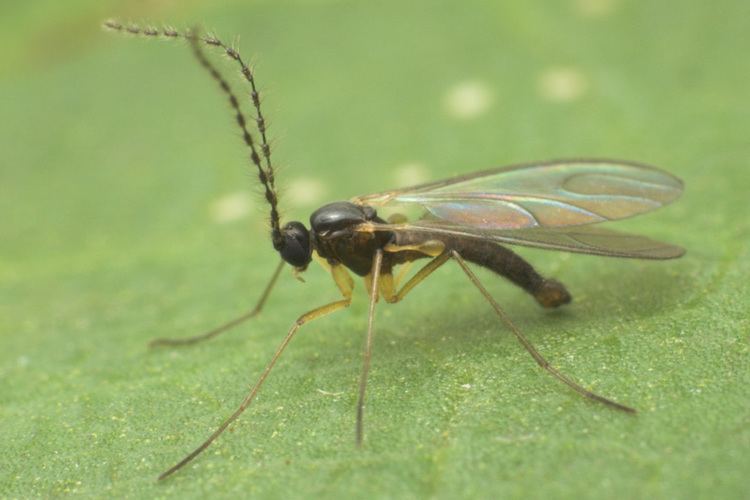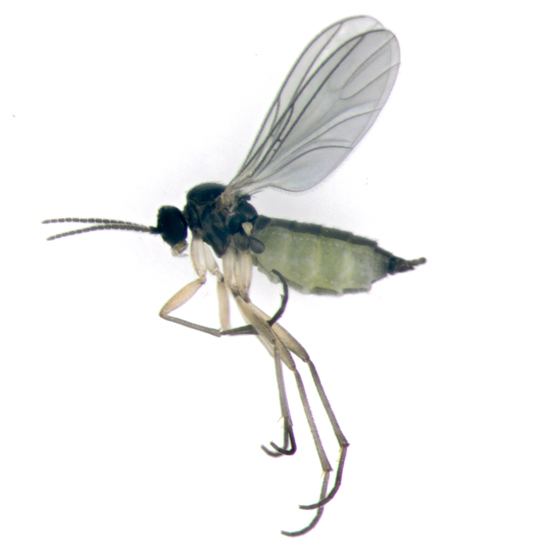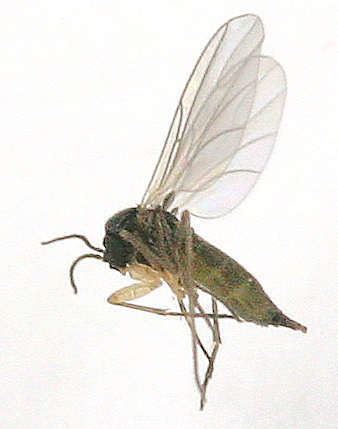Infraorder Bibionomorpha Scientific name Sciaridae Rank Family | Suborder Nematocera Higher classification Bibionomorpha | |
 | ||
Lower classifications Sciara, Sciara analis, Corynoptera | ||
Sciaridae family the larvae of dark winged fungus gnats
The Sciaridae are a family of flies, commonly known as dark-winged fungus gnats. Commonly found in moist environments, they are known to be a pest of mushroom farms and are commonly found in household plant pots. This is one of the least studied of the large Diptera families, probably due to the small size of these insects and the difficulty in specific identification.
Contents
- Sciaridae family the larvae of dark winged fungus gnats
- Description
- Family description formal
- Distribution
- Species lists
- Life cycle
- Mating and genetics
- Evolution
- Pest status
- References

Currently, around 1700 species are described, but an estimated 20,000 species are estimated to be awaiting discovery, mainly in the tropics. More than 600 species are known from Europe.

Description

These gnats are small, from one to at the very most seven millimetres long. They have slender, darkly coloured bodies and dark wings. However, the females of several species are wingless. Their long legs and antennae with eight to 16 segments are typical of many gnats.
Family description (formal)
See [1] and images at Diptera.info
The slender whitish larvae feature a sclerotized head capsule.
Distribution

The Sciaridae occur worldwide, even in extreme habitats such as subantarctic islands and mountainous regions above 4,000 m. Others (such as Parapnyxia) are found in deserts, where they dig into the sand at extreme temperatures. Several species live exclusively in caves. However, most species live in forests, swamps, and moist meadows, where they live in the foliage. They are also often found in flowerpots. In moist and shadowy areas, up to 70% of all dipteran species can be Sciaridae.

They are distributed through wind and drifting, for example on dead wood, and are often introduced by humans, by means of transported humus or similar.
Species lists
Life cycle
The life cycle of only a few species has been studied in any detail, mainly those which are pests of commercially grown mushrooms. Sciarid larvae are mainly found in soil and plant litter, where they seem to feed mainly on fungi and animal faeces. Also, some species mine in plant parts above and below the earth. The larvae play an important role in turning forest leaf litter into soil.
Adult females lay about 200 transparent eggs (each about 1 mm long) into moist soil. After about one week, the larvae hatch. About 90% of the larvae are female. Up to 2,500 per m² can be found. Several species, especially Sciara militaris, can be found to migrate in processions of up to 10 m, containing thousands of individuals. These processions occur from May to June in central Europe. The larvae there pupate from July to August.
The adults with their characteristic dancing flight do not bite. They only ingest liquids and live only long enough to mate and produce eggs. They die after about five days.
The use of cedar wood chips is one way to keep Sciaridae away from plants.
Mating and genetics
The Sciaridae practice paternal genome elimination, whereby the male passes on only the genetic material of his mother to his offspring. The functional result of this is similar to haplodiploidy, but via a very different mechanism.
Evolution
Sciarids are fairly common in amber deposits, with the earliest known fossils dating from the Cretaceous period.
Pest status
Sciarid flies are common pests of mushroom houses and of plants grown in protected culture, for example herbs, where the warm and moist conditions favour their rapid development. In commercial mushroom houses, sciarid fly larvae tunnel into the stalks of the mushrooms, and feeding damage can sever developing mycelium, causing mushrooms to become brown and leathery. Their faeces may also prevent the mycelium from colonising the casing layer, severely reducing yields. As a pest of plants, sciarid larvae feed on the root system. In both industries, adult sciarid flies are a nuisance pest that can result in crop rejection if high numbers are present in the growing area.
The damaging larval stage can be controlled using the beneficial nematode Steinernema feltiae, which enters the larva and releases a bacterium that kills the insect. The nematode then reproduces within the larva and its young are released into the growing medium, where they actively search out new host larvae.
